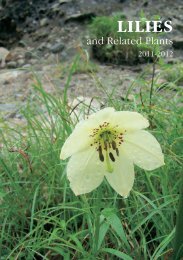LILIES - RHS Lily Group
LILIES - RHS Lily Group
LILIES - RHS Lily Group
You also want an ePaper? Increase the reach of your titles
YUMPU automatically turns print PDFs into web optimized ePapers that Google loves.
suggestion that White grew or certainly knew of the existence of the “new” North<br />
American lilies.<br />
Lilium superbum<br />
This species is grown at the Wakes. Synge writes “Lilium superbum was one<br />
of the earliest American lilies to be introduced into Britain”. He says that Peter<br />
Collinson grew it in his garden at Mill Hill and it flowered for him in 1738. A<br />
specimen in his garden was painted by the German artist Georg Dionysus Ehret,<br />
perhaps the most famous botanical artist of the period. This painting is in the<br />
Victoria and Albert Museum in London. As with Lilium philadelphicum White<br />
would almost certainly have been aware of this species.<br />
Gilbert White died in Selborne in 1793. He never married. He is buried in the<br />
cemetery at St Mary’s Church, Selborne. St Mary’s was built in around 1180 on<br />
the site of a Saxon church. In the gales of 1990 the Churchyard yew tree was<br />
blown down. White would have known this tree well as it was almost opposite<br />
his house. The Yew was believed to be 1400 years old.<br />
White’s life spanned the American and the French Revolutions. The wind<br />
of change was upon Britain at the end of his life and the day of the Industrial<br />
Revolution was soon to dawn signalling the move away from a rural economy.<br />
His writings would be read by Keats and Coleridge. Jane Austen in the Hampshire<br />
village of Chawton, just a few miles from Selborne, would a few years later write<br />
her famous novels. White could never have imagined that the well recorded<br />
observations of a clergyman living in a small Hampshire village with around 600<br />
inhabitants in eighteenth century England would have been translated into several<br />
languages, in many separate editions and publications and be read around the<br />
world. He could never have thought that the Natural History of Selborne would<br />
survive his death by over 200 years and have such a wide readership today..<br />
Internet references:<br />
Gilbert White’s House and the Oates Museum http://www.gilbertwhiteshouse.org.uk/<br />
The Bewick Society http://www.bewicksociety.org<br />
The Project Gutenberg collection where you can read part of the Natural History<br />
of Selborne. There may be copyright restrictions in some countries.<br />
http://www.gutenberg.org<br />
Visit the BBC Four Michael Wood website where you can see video clips and<br />
footage of Selborne from the series Gilbert White, The Nature Man<br />
http://www.bbc.co.uk/bbcfour/documentaries/features/gilbert-white.shtml<br />
Readers with broadband internet access can digitally view The Natural History of<br />
Selborne online at: http://www.archive.org/details/naturalhistoryan02whituoft<br />
with the kind permission of Canadian Libraries and the University of Toronto<br />
With many thanks to David Standing and the members of staff at the Gilbert White’s House<br />
and the Oates Museum, Selborne, Hampshire, UK for their assistance with this article.<br />
103




